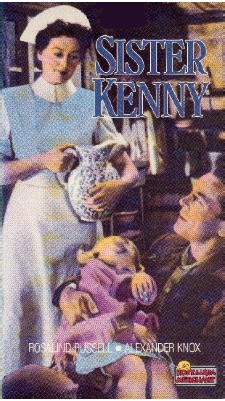
This movie is based on the book, And They Shall Walk: The Life
Story of Sister Elizabeth Kenny,
written in collaboration with Martha Ostenso, 1943.

This 1946 film stars Rosalind Russell as Sister Elizabeth Kenny, a nurse from Australia. Miss Russell insisted that the movie be made; and won a Golden Globe in 1947. That same year she also received an Academy AwardŽ Nomination for the movie.
As a nurse in the outback in Australia, Sr. Kenny found that there was no treatment for "infantile paralysis." And, she was told to treat the symptoms presented. That's exactly what she did, and the child recovered. What worked for her was pieces of wool (torn from blankets) that were soaked in hot water and rung out so they wouldn't burn the skin. Properly done, they provided relief for the affected muscles. Next, she attempted to retrain the muscles. This was the beginnings of the famous Kenny Method to treat polio. However, Sr. Kenny's unorthodoxed methods were not embraced by the medical doctors (either in Australia or England).
In 1940, she brought her polio treatments to the USA where her methods
were given at least given a chance. The Sister
Kenny Institute, established in 1942, is now part of Abbott Northwestern
Hospital in Minneapolis, MN. "Sister Kenny's pioneering principles
of muscle rehabilitation became the foundation of physical therapy."
(quote from the Sister Kenny Institute website)
Dr. Henry Holland, a polio survivor from Virginia, writes: "I thought at least two of the children with polio were real victims, a little boy with crutches and braces and a little girl with braces. The surgical amphitheatre pictured during the confrontation between the orthopedic doctors (Dr. Brach) and Sister Kenny brought back memories of my own medical training. However, I would like to say that this movie was a Hollywood production and was not a documentary."
Karolyn Grimes, who was Carolyn (a little girl with polio in the movie) sent me this picture of herself with Sister Kenny and Rosalind Russell.
Many Polio survivors will recognize themselves and the treatments
portrayed in the movie. It also shows what this Polio Pioneer gave
up to dedicate her life to improving the lives of victims of the Polio
Epidemics.
Rosalind Russell's autobiography: Life is a Banquet
For more reviews of Polio Books, go to Jann's Bookstore Reviews
Elizabeth Kenny, the daughter of Michael and Mary Kenny, was born September 20, 1886* in New South Wales, Australia. At 16 she graduated from St. Ursula's College, Queensland, Australia. She received her nursing training at a private hospital and served as a nurse in the Australian bush country from 1911 to 1914. It was during this period that she encountered her first case of infant paralysis (1909) and developed her treatment for the disease. During World War I Kenny served as an Australian Army nurse and was promoted to the rank of "sister," the Nurse Corps equivalent to a first lieutenant.
After the war Kenny returned to civilian nursing. Her treatment and concept of infant paralysis gained the recognition of the medical profession and the support of the Australian government. Her clinic at Townsville was given government status and Kenny clinics were established throughout the country.
Kenny came to the U.S. in the spring of 1940 but was disappointed by
the cool reception her treatment technique received on the West and East
coasts. In June 1940 she demonstrated her treatment at the University of
Minnesota Medical School and Minneapolis General Hospital. The medical
personnel at these institutions accepted Kenny's treatment method as an
entirely new concept of infantile paralysis and the first American treatment
center was opened at Minneapolis General Hospital. In December 1942 the
City of Minneapolis established the Elizabeth Kenny Institute and the following
year the Sister Elizabeth Kenny Foundation was formed to financially support
the Institute's work and to forward the teaching of the Kenny method throughout
the U.S. and abroad. Elizabeth Kenny died November 30, 1952 at her home
in Toowoomba, Australia.
[This biographical information is from the Kenny collection at the
Minnesota Historical Society]
*Sr. Kenny was actually born in 1880, not 1886 as often reported.
These 6 years were believed "lost" when Sr. Kenny adopted Mary. Sr.
Kenny was probably the first single woman to adopt a child in Queensland.
More details on this webpage: Article:
"Sister Elizabeth Kenny's gravestone set right"